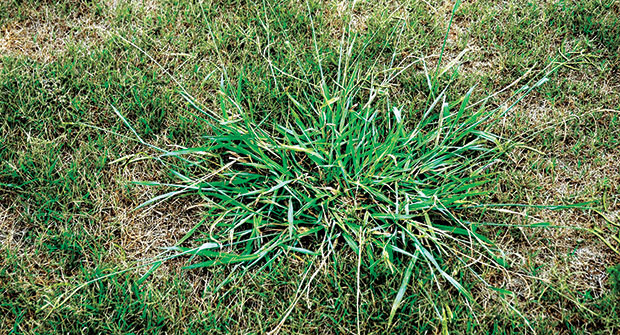
A grassy weed that produces many seeds and grows in thick, unsightly clumps in turf, dallisgrass can be tricky to deal with in the warmer months. Read on for ways to spot and eradicate this turfgrass problem.
Know your enemy
- Perennial, warm-season, grassy weed;
- Grows in thick clumps;
- Tends to grow more aggressively in open, sunny areas;
- Wide leaf blade measuring ¼- to a ½-inch wide that can have a “dull” green appearance;
- Very tall membranous ligule (where the leaf blade meets the sheath);
- Most visible during summer when it’s forming seedheads, which can grow a foot or more above the turf canopy;
- Features large spikelets that protrude from the main branch and stalk, each of which contains three rows of seeds that can turn dark in color;
- Unique seedheads that branch perpendicularly from the stalk;
- Contains large underground rhizomes that store carbohydrates for overwintering — this attribute can make control difficult because new leaves easily grow back from the rhizomes; and
- Can tolerate frequent low mowing.

Combat strategy
- Keep your turfgrass healthy and competitive through proper cultural practices such as mowing, fertilization, irrigation and cultivation;
- Selective herbicide options are very limited and can take multiple years to achieve full control;
- Apply two applications in fall and one in spring — and avoid summer herbicide applications. Always follow directions on the herbicide label;
- In warm-season turfgrasses, apply a postemergent with the active ingredients trifloxysulfuron-sodium or pinoxaden;
- In cool-season turfgrasses and zoysiagrass, postemergent products containing fluazifop work best;
- Refer to the University of Tennessee Turfgrass Weeds program website (TennesseeTurfgrassWeeds.org) for information on growing and cooling degree days. These details will aid in timing applications for dallisgrass control; and
- No cases of resistance have been reported, but be sure to properly maintain turfgrass through cultural practices and do not rely on a single herbicide mode of action.
Sources: Lane Tredway, Ph.D., technical services manager, Syngenta; Eric Reasor, Ph.D., Southeast research scientist, PBI-Gordon; Bayer Green Solutions Team


